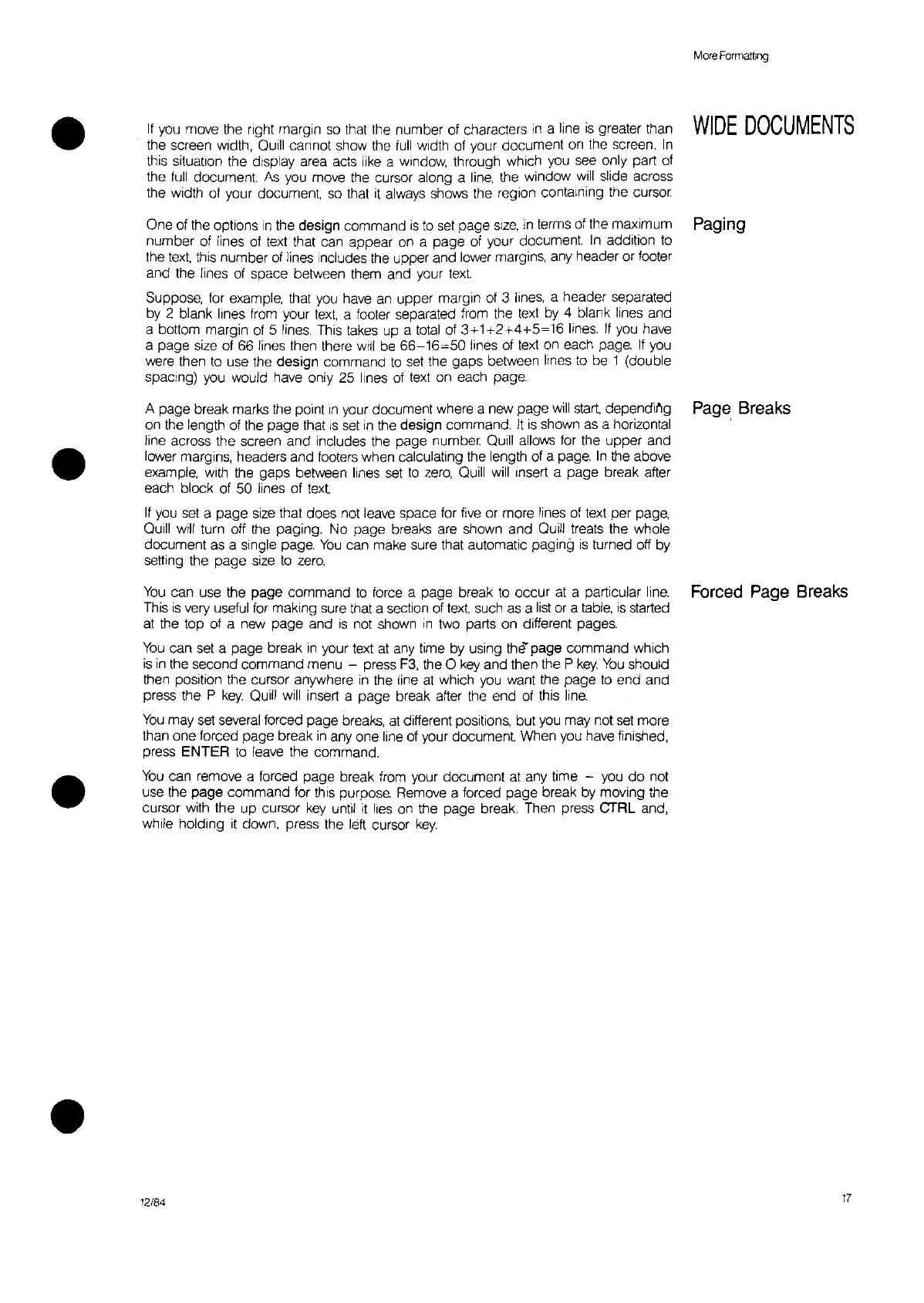•
•
•
More
Formatting
If
you
move the right margin
so
that
the number
of
characfers
in
a line
is
greater than
WIDE
DOCUMENTS
the screen width, Quill cannot show the
full
width
of
your document
on
the screen.
In
this
situation the display area
acts
like
a window, through which you
see
only part
of
the
full
document.
As
you
move the cursor along a
line,
the window
will
slide across
the width
of
your document,
so
that
it
always
shows the region containing the cursor
One
of
the oplions
in
the design command
is
to
set
page
Size,
in
terms
of
the maximum
Paging
number
of
lines
of
text
that can appear on a page
of
your document.
In
addition
to
the
text.
this number
of
lines Includes the upper and lower margins, any header or footer
and the lines
of
space between them and your
text.
Suppose, for example, that you have
an
upper margin
of
3
lines,
a header separated
by
2 blank lines
from
your
text.
a footer separated from the
text
by
4 blank lines and
a bottom margin
of
5
lines.
This
takes
up a
total
of
3+1+2+4+5~16
lines.
If
you
have
a page
size
at
66 lines then there
will
be
66-16=50
lines of
text
on each page.
If
you
were then
to
use the design command
to
set
the gaps between lines
to
be
1 (double
spacing) you would have only 25 lines
of
text
on each page.
A page break marks the point
In
your document where a new page
will
start,
dependl~g
Page,
Breaks
on the length of the page that
IS
set
in
the design command.
It
is
shown
as
a horizontal
line across the screen and includes the page number. Quill allows
for
the upper and
lower margins, headers and footers when calculating the length of a page.
In
the above
example,
With
the gaps between lines
set
to
zero,
Quill
will
Insert a page break after
each block of
50
lines of
text.
If
you
set
a page
size
that does not leave space for
five
or more lines
of
text per page,
Quill
will
turn off the paging. No page breaks are shown and Quill treats the whole
document as a single page.
You
can make sure that automatic paging
is
turned off by
setting the page
size
to
zero.
You
can use the page command
to
force a page break
to
occur
at
a particular
line.
Forced
Page
Breaks
This
is
very useful
for
making sure
that
a section
of
text.
such
as
a
list
or
a
table,
is
started
at
the top
of
a new page and
is
not shown
in
two parts on different pages.
You
can
set
a page break
in
your text
at
any
time by using
the
page command which
is
in
the second command menu - press
F3,
the 0
key
and then the P
key.
You
should
then position the cursor anywhere
in
the line
at
which
you
want the page
to
end and
press the P
key.
Quill
will
insert a page break after the end of
this
line.
You
may
set
several forced page breaks,
at
different positions, but
you
may not
set
more
than one forced page break
in
anyone
line of your document. When you have finished,
press
ENTER to leave the command.
You
can remove a forced page break
from
your document
at
any time - you
do
not
use the page command for this purpose. Remove a forced page break
by
moving the
cursor
with
the up cursor
key
until
It
lies
on
the page break. Then press
CTRL
and,
while holding
it
down, press the left cursor
key.
12/84
17

